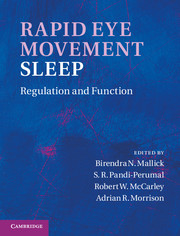Book contents
- Frontmatter
- Contents
- Contributors
- Preface
- Acknowledgments
- Organization
- Section I Historical context
- Section II General biology
- Section III Neuronal regulation
- Section IV Neuroanatomy and neurochemistry
- Section V Functional significance
- 30 Significance of deprivation studies
- 31 Modulation of body core temperature in NREM sleep and REM sleep
- 32 Sleep-related hippocampal activation: implications for spatial memory consolidation
- 33 The role of REM sleep in memory consolidation, enhancement, and integration
- 34 The role of REM sleep in emotional brain processing
- 35 REM-sleep loss, oxidative damage, and apoptosis
- 36 The role of REM sleep in maintaining neuronal excitability and its possible mechanism of action
- 37 Comparison of REM sleep-deprivation methods: role of stress and validity of use
- 38 REM sleep in patients with depression
- 39 Proteins and neuropeptides in REM-sleep regulation and function
- Section VI Disturbance in the REM sleep-generating mechanism
- Index
- Plate section
- References
36 - The role of REM sleep in maintaining neuronal excitability and its possible mechanism of action
from Section V - Functional significance
Published online by Cambridge University Press: 07 September 2011
- Frontmatter
- Contents
- Contributors
- Preface
- Acknowledgments
- Organization
- Section I Historical context
- Section II General biology
- Section III Neuronal regulation
- Section IV Neuroanatomy and neurochemistry
- Section V Functional significance
- 30 Significance of deprivation studies
- 31 Modulation of body core temperature in NREM sleep and REM sleep
- 32 Sleep-related hippocampal activation: implications for spatial memory consolidation
- 33 The role of REM sleep in memory consolidation, enhancement, and integration
- 34 The role of REM sleep in emotional brain processing
- 35 REM-sleep loss, oxidative damage, and apoptosis
- 36 The role of REM sleep in maintaining neuronal excitability and its possible mechanism of action
- 37 Comparison of REM sleep-deprivation methods: role of stress and validity of use
- 38 REM sleep in patients with depression
- 39 Proteins and neuropeptides in REM-sleep regulation and function
- Section VI Disturbance in the REM sleep-generating mechanism
- Index
- Plate section
- References
Summary
Summary
Sleep has been generally divided into rapid eye movement (REM) sleep and non-REM (NREM) sleep in higher order mammals, including humans. Several theories have proposed various functions of different stages of sleep. We hypothesized that REM sleep maintains brain excitability. In this chapter, we discuss the significance of REM sleep in the maintenance of neuronal electrochemical homeostasis, which governs brain excitability. Selective REM-sleep loss increases the activity of Na-K ATPase, a membrane-bound enzyme that maintains neuronal Na+ and K+ homeostasis and, thus, the neuronal resting membrane potential. Further, the REM sleep deprivation-induced increase in Na-K ATPase activity has been attributed to an increased level of norepinephrine in the brain.
- Type
- Chapter
- Information
- Rapid Eye Movement SleepRegulation and Function, pp. 359 - 367Publisher: Cambridge University PressPrint publication year: 2011



